This juicy, succulent Mojo Cuban Roast Pork (Lechon Asado) is big on flavor and low on effort – just sit back while the marinade and the oven do all the work!
This mojo pork is dripping with fantastically fresh Caribbean flavors and a beautiful caramelized crust that you won’t be able to get enough of! It’s made by marinating the pork in a bath of garlic, citrus, cilantro, mint, jalapeño, oregano, cumin overnight and the next day just popping it on the oven to roast low and slow for a few hours. The emerging mojo Cuban roast pork is mouthwateringly tender with subtle notes of bright, zesty, tangy, herby, garlicky, peppery flavor all at the same time. The mojo marinade is quick and easy to whip up in your food processor and can even be prepped a day ahead. This mojo pork also makes the best Cuban Sandwiches! or it can be used in tacos, nachos, rice bowls, etc. The leftovers also freeze great – should you be so lucky.
Pork recipes from slow roasted to quick skillet dinners are some of my favorites! Mix up the monotony of chicken with pork carnitas, garlic butter pork tenderloin, grilled pork tenderloin, brown sugar pork chops, BBQ pulled pork and the best pork chop marinade.
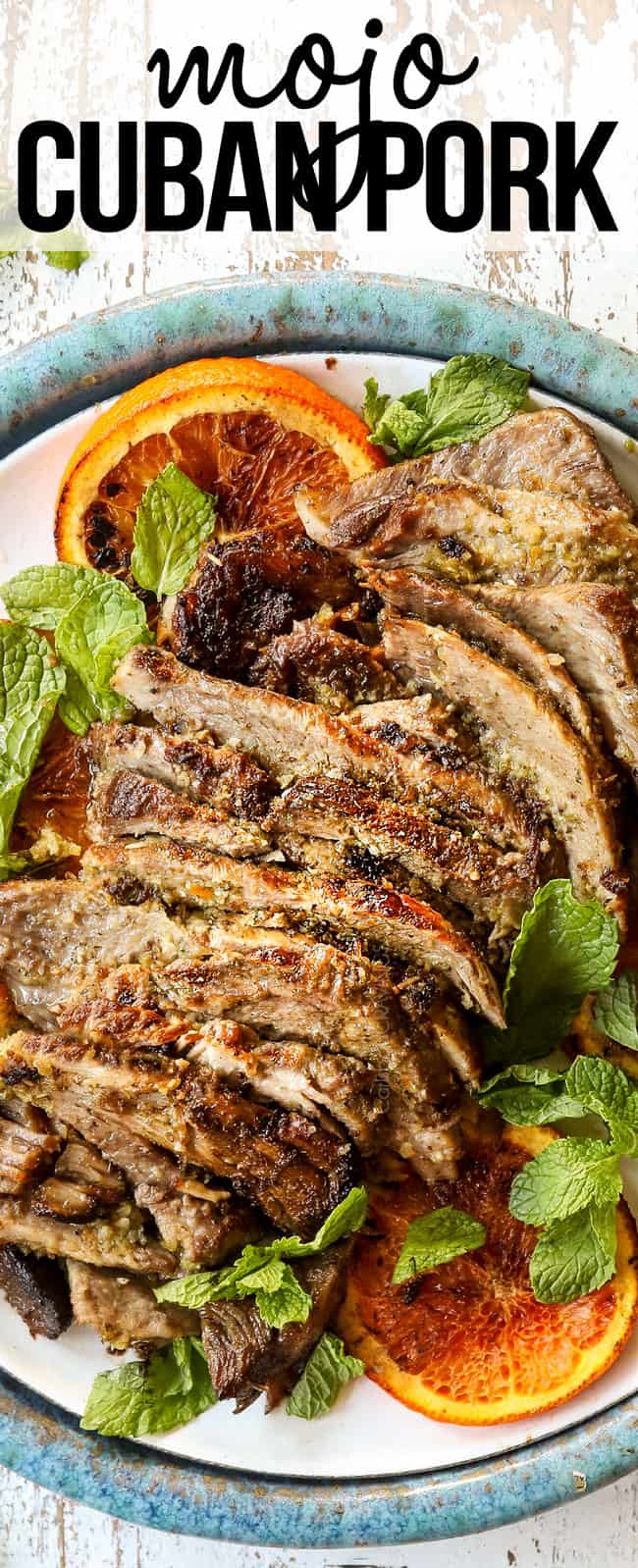
WHAT IS LECHON ASADO?
This mojo Cuban roast pork recipe is inspired by Cuban lechon asado. Technically lechon means “suckling pig” (i.e. young) in Spanish, and refers to slow roasting a whole young pig in a fire pit or underground covered banana leaves. Lechon asado is popular in many countries including Cuba, Spain, Puerto Rico, Dominican Republic and the Philippines; it is even described as a national dish of Cuba, Puerto Rico, and Spain.
What sets Cuban lechon asado apart is the mojo marinade made up of tangy orange juice, a plethora of garlic, cumin, and oregano. The marinated mojo pork is reserved for special occasions and celebrations because roasting is a whole day affair. Lechon asado is often the centerpiece of a Cuban Nochebuena, or Christmas Eve dinner, as well as weddings, New Year’s, birthdays, etc. On Christmas Eve, the Cuban skies will fill with fragrant smoke as everyone roasts their own mojo pork.
MOJO Roast PORK RECIPE
The essence of traditional lechon asado can be achieved at home by marinating and roasting a more manageable cut of pork, such as the pork shoulder, low and slow in the oven for about 4 hours. The results are jaw dropping; definitely one of the best roast pork recipes I’ve ever had. I attribute this to marinating the pork in the garlicky-citrus mojo sauce overnight. The mojo pork is crazy juicy, seeping with subtle garlic and citrus notes that still let the succulent pork shine..
More reasons WHY YOU’LL LOVE THIS mojo pork RECIPE:
- FLAVOR. The mojo pork marinade boasts fresh herbs and bright, tangy, garlicky, sour notes. The clean citrus backdrop highlights the garlic and herbs while the pepper and jalapeno amp up the flavor without making the dish spicy. For even extra flavor, you can serve the Cuban roast pork with as much or as little reserved mojo sauce.
- EASY. This mojo pork recipe is one of those almost effortless recipes that tastes like you have been slaving in the kitchen all day – when in actuality, the marinade and oven can take most of the credit (it will be our secret). To make lechon asado, you’ll take 5 minutes to chop the marinade ingredients in your food processor, marinate the pork, sear the pork, then bake the pork while your home fills with the exotic aroma of anticipation.
- MAKE AHEAD FRIENDLY. To that end, this Cuban roast pork is fabulous for make ahead meals because everything can be prepped ahead so all you have to do is pop it in the oven then serve. The mojo pork recipe also reheats beautifully so you can make it on Sunday and be grateful for leftovers throughout the week.
- BEST LEFTOVERS. Remember those leftovers? You will be so grateful you have them to make Cubano Sandwiches! I have recipe coming your way shortly and it is epic – because this mojo pork is epic. You can also reinvent the leftovers every time you serve them into something different from rice bowls to tacos, to quesadillas to nachos.
- DOUBLE OR TRIPLE. The mojo pork marinade can also be doubled or tripled and frozen for later so you have everything you need for lechon asado at your fingertips.
- FREEZER FRIENDLY. Whether you want to prep ahead or stash leftovers, Cuban roast pork freezes beautifully. Now, just grab some from the freezer for quick and easy lunches or dinners throughout the week.
WHAT IS MOJO?
What transforms lechon asado into Cuban lechon asado is the mojo marinade. Mojo is a Spanish word meaning “sauce” that originated in the Canary Islands. Its influence expanded to Cuba, Puerto Rico, Dominican Republic and all throughout the Caribbean due to heavy Canarian emigration. As such, mojo has expanded to describe different sauces of different regions consisting of olive oil, local chilies, garlic, cumin and cilantro. Each country has slight variations using different acids such as vinegar, lemon juice or orange juice or different seasonings.
Cuban mojo is possibly the most popular in the United States. It describes any sauce made with olive oil or pork lard, garlic, oregano and bitter orange juice. It is commonly used to flavor yuca, lechon asado and whole chicken.
Cuban mojo marinade is characterized by the bitter Seville orange that is native to Southeast Asia but is now found in abundance in Cuba. It is such a way of life in Cuba that many Cubans have their own Seville orange trees. The sour flavor of the Seville orange is crucial to the mojo pork marinade but is not widely available throughout the US.
Fortunately, there is an easy substitute: 2 parts orange juice to 1-part lime juice and lemon juice. Add the zest of the orange and now you have all the orange flavor with just the right amount of sour.
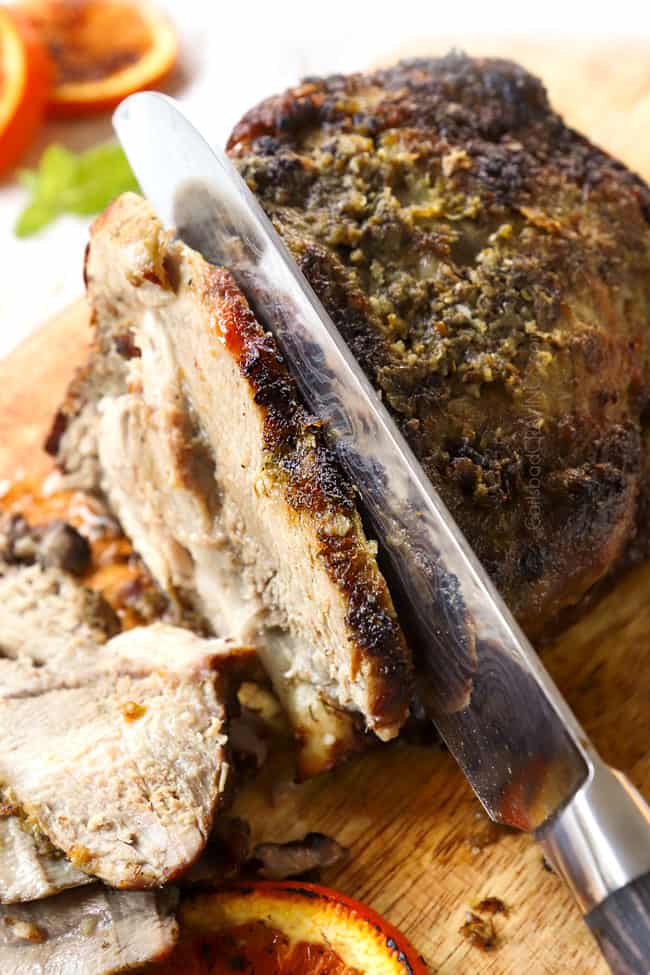
HOW IS MOJO PRONOUNCED?
Mojo is a Spanish word so the j makes an “h” sound like in jalapeno. So, instead of pronouncing mojo “mo-joe,” it is pronounced”mo-ho.”
WHAT DOES MOJO PORK MARINADE TASTE LIKE?
This mojo pork marinade tastes bright, fresh and tangy, zesty, citrusy, garlicky, peppery and slightly sour. You should be able to taste the garlic, pepper and slightly sour notes as they harmoniously blend with the aromatics.
IS CUBAN ROAST pork SPICY?
This Cuban roast pork is not spicy but just flavorful. It has a little kick from garlic, pepper and jalapeno, but is still be mild enough for everyone. If you taste the marinade alone, it will taste strong but the flavor of the pork will be subdued because it only drinks in some of the flavor. You can control how spicy your mojo pork is after cooking by how much reserved marinade you serve it with.
MOJO PORK INGREDIENTS
There are countless variations of mojo pork marinade. Some marinades include cilantro, some don’t, some marinades include jalapeno, some don’t, some include oregano, some don’t (those without oregano are called mojito). This mojo marinade recipe combines the most flavorful elements to create the most dynamic mojo pork. Of course, you can omit or add ingredients to your liking. This mojo marinade is also gluten-free, keto-friendly, healthy and super versatile. Here’s what you’ll need:
- Orange juice: you will need 2 oranges to make ½ cup orange juice. Use freshly squeezed because we also need the zest of one orange.
- Lemon and lime Juice: freshly squeezed is best but you can use bottled juice if it is pure freshly squeezed without any additives.
- Olive oil: use quality extra virgin olive oil for the best flavor.
- Onion: ½ yellow onion will do the trick. Don’t substitute with a sweet onion.
- Cilantro: adds a zesty, citrusy punch. If you don’t like cilantro, just skip it.
- Garlic: adds the signature garlicky flavor. You can use more or less depending on how pronounced you would like the garlic.
- Jalapeño: remove the seeds and membrane before roughly chopping because they contain most of the heat.
- Ground cumin: adds a smokey, earthy undertone that rounds out the flavor profile and punches up the other flavors.
- Dried oregano: is a classic addition to lechon asado. It’s aromatic, earthy, and minty.
- Salt: is crucial! It enhances all of the flavors, especially the garlic. If you don’t have enough salt, the marinade will taste very bland. If that’s the case, make sure to salt your Cuban roast pork to taste.
RECIPE VARIATIONS
You can make this mojo pork as spicy as you want by adding more or less jalapenos and pepper, as garlicky as you want by adding more or less garlic, as herby as you want by adding more or less cilantro and/or oregano or as sour as you want by adding more or less lime/lemon juice. For us, however, it’s perfect just the way it is.
Here’s how to customize your mojo pork marinade:
- Control the heat by omit the jalapenos or adding more jalapenos
- Swap heat source by using red pepper flakes instead of jalapenos
- If you hate cilantro, swap it for parsley or omit it
- If you love cilantro, add even more
- Control the garlic by adding more or less to taste
- Make it more sour by adding more lemon juice and less orange juice or less sour by adding less lemon juice
- Mix up the flavor profile by adding other seasonings/flavorings such as paprika or chipotle chile powder
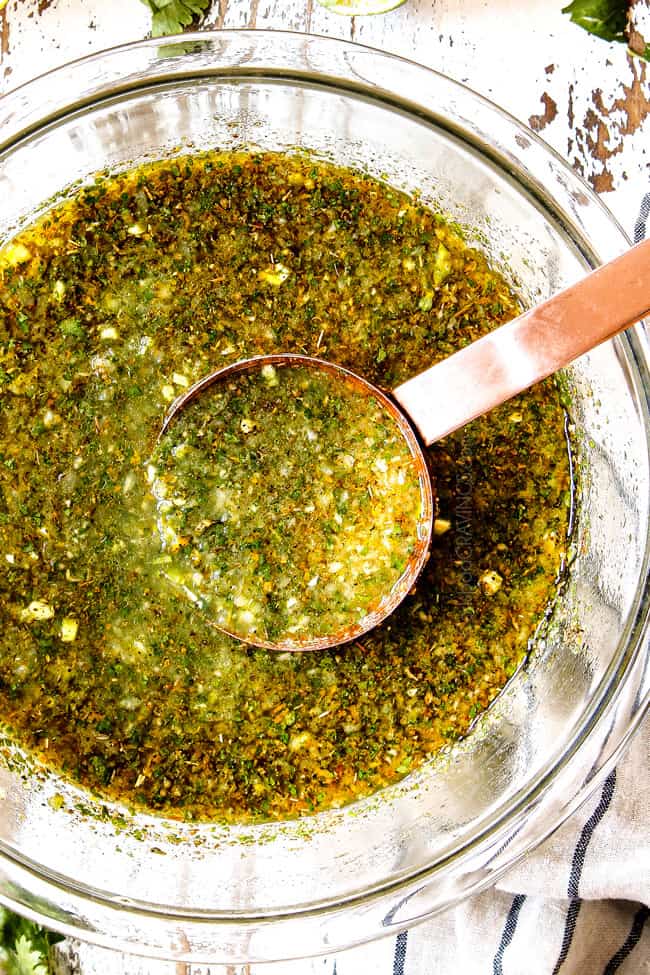
What Is the Best Cut for Cuban Roast pork?
Mojo Cuban roast pork can be made with either a 4-6-pound pork shoulder or Boston butt. Both come from the shoulder of the pig and not the rear. Pork shoulder comes from the shoulder area just above the forelegs and Boston butt comes from the area stacked vertically above that.
If you have a choice between Boston pork butt and pork shoulder, choose pork butt. It is named after the barrels (butts) pork used to be stored in around the time of the Revolutionary War. Pork butt has more fat marbling throughout the meat so it emerges more tender.
With or without the bone?
You want to choose bone-in pork for maximum flavor and juiciness. The bone serves as a conductor which helps the pork cook more evenly and prevents it from drying out so it emerges wonderfully juicy. In the case of boneless pork, the pork is cut open to remove the bone which leaves more muscle exposed during cooking which makes it dry out faster. Bone-in pork is also less expensive because it’s less processed – win, win!
Fat cap on or off?
Boston butts have a fat cap, a layer of hard white fat that sits on top of the meat, sometimes as much has an inch thick. I recommend trimming all of it except 1/8-inch. The thin layer of remaining fat will create a self-basting effect as it breaks down and drips over the meat, resulting in extra juicy and extra flavorful pork, with little surface fat remaining after roasting.
If you leave thicker fat on the pork, most people will trim it off as they eat, along with the wonderful caramelization and browning flavors created by the Maillard reaction.
Skin on or off?
Since this is an easy home adaptation of lechon asado, I opted for pork with the skin off, but if you can find pork shoulder with the skin on and want the skin – then go for it.
HOW LONG TO MARINATE lechon asado?
I recommend marinating lechon asado 12-24 hours for maximum juiciness, tenderness and flavor. Pork roast is a tough, thick cut and needs all 12 hours for the marinade to work its magic. Don’t marinate the Cuban pork for any longer than 24 hours because the mojo marinade is highly acidic and the citrus enzymes can break down the protein and make it mushy.
HOW DOES THE MOJO Pork MARINADE WORK?
This mojo pork marinade tenderizes and flavors the pork so all you have to do is marinate and cook! In order for a marinade to be effective, it must contain acid, fat, salt and flavor enhancers. The combination of these elements ensures that the protein is juicy, succulent and flavorful from the inside out. Here’s how it works:
- FAT: the olive oil dissolves fat-soluble flavor compounds from the seasonings and aromatics and evenly disperses them throughout the pork. Fat also adds moisture to the protein.
- ACID: the orange juice, lime juice and lemon juice help tenderize the pork by breaking down lean muscle fibers. The citrus trio also boast layers fresh, bright, tangy flavor.
- SALT: creates a brine, which increases the moisture capacity of the protein, helping it become juicer and more flavorful. First, the salt hydrates the muscle tissues via osmosis; second, it changes the cells’ structure so that they can no longer contract when cooking. This means less water will be squeezed out and lost, resulting in juicier pork. Finally, the brine draws the aromatic flavor further down below the surface into the protein and enhances all of the flavors. You can pile on herbs and seasonings but if a marinade is missing salt – it will taste bland.
- FLAVOR ENHANCERS: citrus, garlic, onion, cilantro, jalapeno and pepper flavor the pork.
How to roast lechon asado at home
This Cuban roast pork recipe requires a few steps, but each step is very simple. It can be divided into marinating the pork, searing the pork and roasting the pork. Here’s how:
- Finely chop fresh mojo ingredients in food processor. Mojo marinade is traditionally made by blending garlic, coarse salt, peppercorns, etc. with a mortar and pestle. This recipe, however, utilizes the modern-day food processor so all you have to do is roughly chop (barely) the onion and jalapeno before adding to the food processor. Combine with cilantro, mint and peeled garlic and pulse until finely chopped.
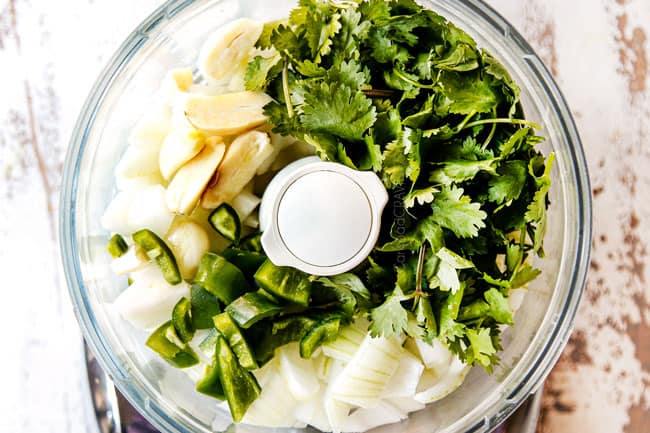

- Combine the rest of the ingredients in a bowl. Next, transfer the chopped fresh ingredients to a large bowl. Add the orange juice, orange zest, lime juice, lemon juice, ground cumin, dried oregano and olive oil, and give everything a stir. You don’t want to add the liquid ingredients to the food processor or it will leak out the bottom.
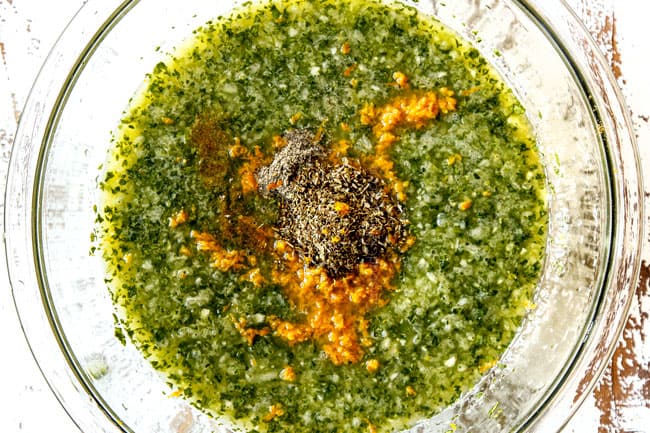
- Reserve marinade. Remove 1 ½ cups marinade to serve with Cuban roast pork.
- Marinate. Transfer marinade to a freezer bag and add the pork; turn to coat, squeeze out excess air and seal. Marinate the pork in the refrigerator for 12-24 hours (no longer!), turning the bag occasionally.

- Bring pork to room temperature before cooking. You always want to let any protein sit at room temperature before cooking. For such a large cut of protein, remove the pork from the refrigerator and let it sit on the counter for 60 minutes before cooking. This helps the pork cook more quickly and more evenly.
- Sear pork. After marinating, wipe off excess marinade and sear the pork on all sides to develop flavor and to seal in the juices. I recommend a cast iron skillet because it gets piping hot and cooks more evenly. Also, take care to use vegetable oil because you need an oil with a high smoking point – don’t substitute olive oil. Make sure you brown the pork on all sides until deeply golden. You can use tongs or two forks to rotate your pork.
- Roast. Place the pork on a rack in a roasting dish. If you don’t have a rack, place it on two halved onions with 1 cup of water. Tightly cover with foil, slightly tented in the middle so it is not touching the pork. Roast pork for about 4 hours, adding additional water as needed so it doesn’t dry up.
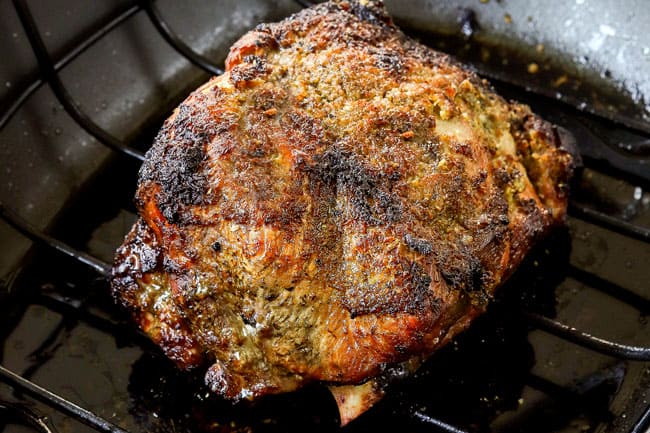
- Simmer mojo. Transfer the reserved 1 ½ cups unused mojo sauce to a saucepan and simmer for 5 minutes while stirring occasionally, or until reduced by half. Mojo is pungent raw and can be overwhelming. Simmering it softens the harshness of the onions and garlic and further melds the flavors together.

WHAT TEMPERATURE SHOULD I roast cuban pork at?
Pork shoulder needs to be roasted low and slow so the marbling throughout the meat has plenty of time to break down to create juicy, tender pork. Slow-roasting also means less moisture loss which also creates a juicier pork. First, roast the pork at 425 F for 30 minutes to further seal in the juices then reduce the temperature to 325 F.
Should I add water to a pork roast?
To create the juiciest lechon asado, our goal is to keep as much of the juices in the pork roast as possible. This can be achieved by creating a moist environment by adding water to the pan and covering with foil. Adding water helps prevent the pork from drying out and allows you to baste the pork while it roasts.
How long to cook Cuban roast pork?
Cuban roast pork is a low stress, low maintenance roasting experience, because unlike pork tenderloin, it’s actually supposed to cook until past “done.” In fact, this cut of meat is so flexible and forgiving that overcooking the roast even by an hour or two would still render tender juicy Cuban roast pork instead of dry or rubbery pork.
The roasting time in this recipe yields a juicy roast that’s carvable tender but not shreddable tender. If you happen to cook it too long, the worst thing that can happen is that it becomes too tender to carve and you have to shred it. Win-win.
WHAT TEMPERATURE SHOULD I COOK MOJO pork TO?
Pork shoulder should be cooked to 180-190 degrees F for carvable tender, 205 degrees F for shreddable tender. This is far past the 145 degrees for safe consumption. The high internal temperature allows collagen to break down, making the meat melt in your mouth juicy.
HOW TO MAKE MOJO PORK IN THE SLOW COOKER
You can also make mojo pork in the slow cooker but you’ll still want to transfer to the oven a the end of cooking to achieve that coveted caramelized crust, unless you choose to shred your pork. To make in the slow cooker:
- Marinate and sear the pork per recipe directions.
- Place in a 6 quart (or larger) slow cooker along with the marinade.
- Cover and cook on HIGH for 5-6 hours or on LOW for 8-10 hours or until carvable tender.
- Transfer cooked pork to a baking sheet and bake in a 400-degree F oven for 15-20 minutes until the exterior is browned.
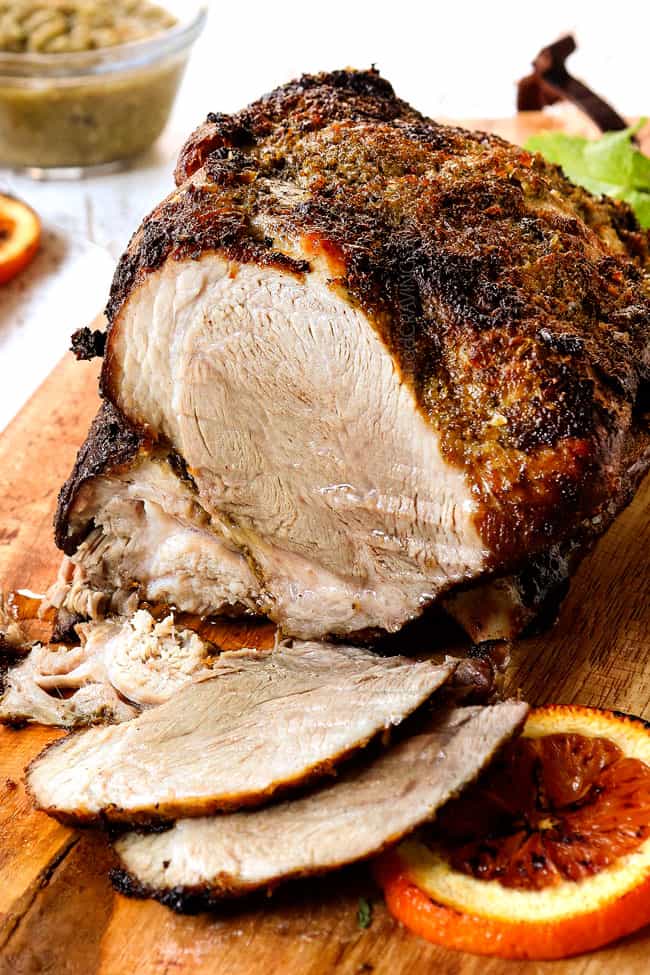
Cuban Mojo Pork Recipe Tips
- Use leftover mojo. The mojo marinade makes enough to marinate up to 6 pounds of protein. If you’re using a smaller pork butt, you can reserve more than 2 cups of the mojo and use it on vegetables, eggs, fish, chicken etc.
- Adjust to taste. The mojo marinade should be garlicky, peppery and slightly sour. Remember the marinade will taste 1000X stronger than your finished protein because it is concentrated. You can adjust to taste by adding more or less of any of the ingredients. You can make it spicier by adding additional jalapenos or reserving the jalapeno seeds and adding them to taste.
- Reserve marinade. Reserve 1 ½ cups marinade to bush all over your sliced Cuban roast pork. You will be amazed at how much flavor this adds but, as with anything, make sure you taste the pork first! You may want just a little mojo or none at all.
- Freeze protein in marinade. If you can’t get to cooking your marinated mojo pork within 24 hours, then you can freeze it in the marinade to use later. That’s a benefit of using the freezer bags – you can just toss them right into the freezer for later!
- Don’t over-marinate. Due to high amount of citrus, don’t marinate the pork longer than 24 hours because the citrus enzymes can break down the protein and make it mushy.
- Let the Cuban Roast Pork rest. After your pork comes out of the oven, transfer it to a cutting board and let rest 15-20 minutes before slicing so it has time to reabsorb the juices that have pushed towards the outside of the protein. If you cut into the pork immediately after cooking, valuable, moisture-giving juices will run out.
- Simmer the reserved mojo. Raw mojo can be overly pungent so you’ll want to simmer the reserved marinade for about 5 minutes to soften the bite of the onions and garlic. At this point, most of the liquid from the mojo will be absorbed/evaporated, so stir in some of the pork drippings to loosen it up for an extra boost of flavor-yum!
MAKE AHEAD TIPS FOR CUBAN ROAST PORK
This mojo Cuban roast pork is fabulous for serving a crowd because most of the work is hands off marinating and cooking which can be done before your guests arrive. To make ahead, I recommend marinating the pork the night before and then popping it in the oven 4 hours before you would like to serve it. This allows you to make any preparations while your pork roasts to drool worthy tenderness without needing to be babysat.
If you are shredding the pork, then you can shred the pork the day before and store it in an airtight container with its juices. The next day, transfer it to your slow cooker and warm for 1-2 hours or you can gently warm on the stove.
The mojo marinade can also be made ahead of time. Transfer mojo to an airtight container such as a sealable bag or jar with a tight-fitting lid. Refrigerate for up to one week in the refrigerator. Transfer to the freezer if storing any longer.
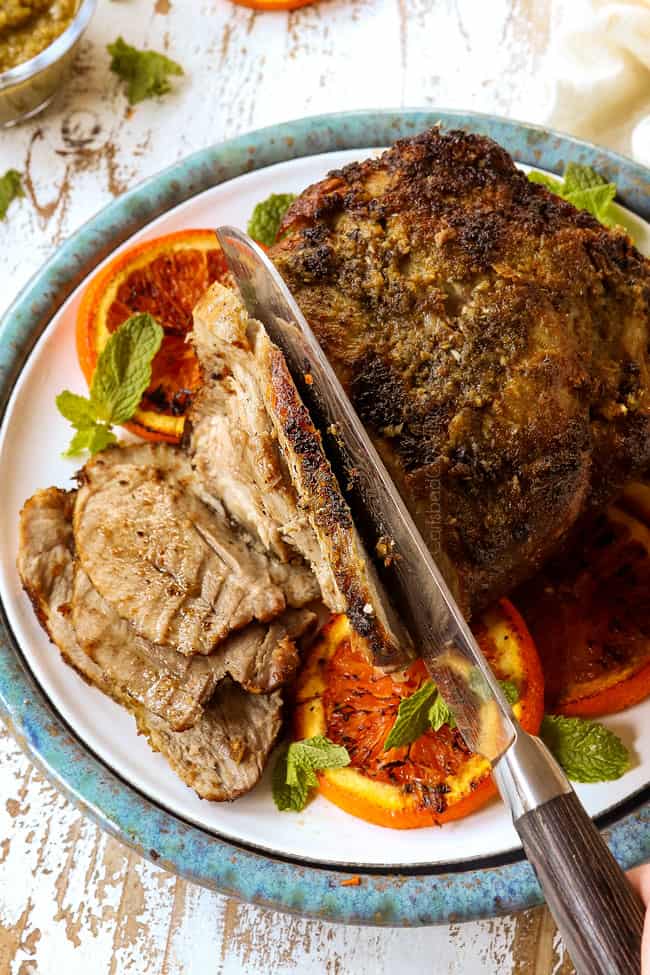
WHAT TO SERVE WITH mojo Cuban roast pork?
Lechon asado would be tasty with any of your favorite Cuban sides such as arroz con maiz, maduros (fried plantains), Cuban black beans or platillo Moros y Cristiano, yuca con mojo (the root of the cassava plant with mojo) or simply white rice, beans, pineapple salsa and salad. Here are some additional traditional and nontraditional serving ideas:
- Rice: Lechon asado is traditionally served with arroz congri which is white rice and black beans cooked together, but you can also cook them separately. Serve with white rice, brown rice, quinoa or low carb cauliflower rice. You can even serve with Cilantro Lime Rice.
- Black beans: serve with Cuban style black beans which you can easily imitate by seasoning black beans with onions, garlic, green bell peppers, oregano, salt, pepper and cilantro.
- Salsa: we love this Cuban pork with rice, beans and fresh salsa! It’s fabulous with mango salsa, pineapple salsa, pineapple mango salsa, corn salsa, black bean salsa, and avocado corn salsa.
- Potatoes: roasted or mashed potatoes are a delicious accompaniment or try mashed sweet potatoes or sweet potato fries with a some reserved mojo as nod to traditional yuca.
- Maduros: are fried sweet plantains that offer a reprieve of sweetness. Try grilling plantains like in these Mojo Salmon Bowls.
- Cornbread or corn casserole: corn casserole is a tasty, easy, creamy win or add some green chiles and or/ jalapenos to my sweet cornbread recipe and watch it disappear.
- Salad: go as simple as a green salad or go big with Mexican salad, southwest salad, corn salad or Southwest orzo salad.
- Vegetables: you can jam all your veggies into the salad or serve salad along with or in addition to elote, baked asparagus, roasted broccoli, roasted cauliflower, roasted Brussels sprouts or roasted butternut squash.
- Fruit: keep it simple and serve this mojo pork with your favorite fruit such as pineapple, cantaloupe, or grapes or amp it up with any of these fabulous options: pina colada fruit salad, fruit salad with honey lime vinaigrette, grape salad, winter fruit salad, or caramelized grilled pineapple.
- Dessert!: finish off your fiesta with churros or Tres Leches Cake for the win!
WHAT TO DO WITH LEFTOVER lechon asado?
This is one recipe you want leftovers of. In fact, you will be making this lechon asado specifically so you can use the mojo pork in various ways, specifically Cubano Sandwiches. So, make this recipe today so you can have leftovers for my Cubano sandwich recipe coming Saturday!
Here are some fun ideas to repurpose leftovers:
- Cuban sandwiches: as previously mentioned, Cuban roast pork is the star of Cubano Sandwiches. They are absolutely drool worthy and take minutes when utilizing leftover lechon asado. The slices of mojo pork get sandwiched in between mustard slathered bread along with ham, Swiss cheese, and pickles then buttered and toasted to crunchy, cheesy perfection.
- Cuban roast pork rice bowls: add warmed rice to a bowl and melt cheese on top if desired. Top with warmed, seasoned corn and beans, chopped lechon asado and your favorite toppings such as fresh or grilled pineapple, fried plantains, mangos, tomatoes, avocado crema or guacamole. Serve with some of the reserved mojo.
- Cuban roast pork salad: chop up the mojo pork and pile leftovers over a bed of chopped Romaine lettuce. Add bell peppers, cucumbers, mangos or pineapple, sliced avocados, pepitas, olives, etc. Thin some of the reserved mojo with olive oil and use as a vinaigrette.
- Cuban roast pork nachos: pile thick restaurant style tortilla chips with cheese and beans and bake. Top with chopped mojo pork and your favorite toppings such as jalapenos, sour cream, guacamole, etc.
- Cuban roast pork quesadillas: layer a burrito size tortilla with Mexican cheese and Cuban mojo pork and grill until golden, cheesy perfection. Serve with your favs of reserved mojo, sour cream, salsa, chopped lettuce, guacamole, etc.
- Tacos: Wrap up chopped mojo pork in a warm tortilla along with black or pinto beans, and desired toppings such as mango salsa, pineapple salsa, corn salsa, black bean salsa, avocado salsa, guacamole, cotija cheese, and sour cream.
- Cuban roast pork stuffed peppers: slice the tops off of 6-8 bell peppers and remove the core/seeds inside. Rub the outsides with olive oil and line in a 9×13 baking dish. Combine chopped lechon asado with some cooked rice, black beans, corn, diced tomatoes and reserved mojo to taste then and spoon into each pepper. Top with Monterey Jack cheese then tent with foil. Bake until peppers are tender, about 35 minutes. Uncover and bake until cheese is bubbly, 10 minutes more. Serve with sour cream or Mexican crema, cilantro, cotija, etc.
- Cuban roast pork tostadas or sopes: layer a tostada or sope with refried beans or avocado mash, top with chopped mojo pork, lettuce or slaw, cilantro, avocados, sour cream, cotija cheese or queso fresco etc. and other desired toppings such as chopped tomatoes, thinly sliced radishes, sliced avocados, pickled jalapenos and/or carrots etc.
- Cuban roast pork pizza: use this pulled pork pizza recipe as a guide for the bean base and swap in chopped lechon asado for the meat. You can also add pineapple, bell peppers and olives.
- Cuban roast pork scrambled eggs or omelettes: add mojo pork to scrambled eggs along with pepper Jack cheese or Monterrey Jack when the eggs are almost set.
- Cuban roast pork frittata: add chopped mojo pork to this scrumptious frittata recipe.
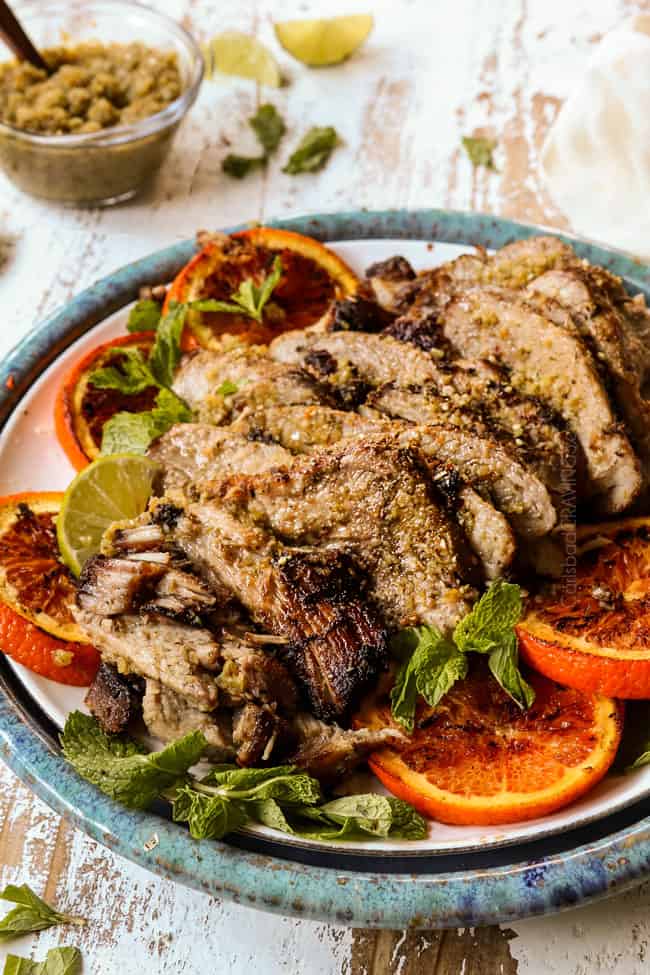
HOW TO STORE and reheat LECHON ASADO
- Storage: Leftover lechon asado should be stored in an airtight container in the refrigerator. It should last up to 4 days.
- Reheat: Leftovers can be reheated in the microwave with some reserved mojo at 30 second intervals (it warms quickly!); or warm leftovers in a skillet with a drizzle of oil over medium-low heat with some reserved mojo until warmed through.
HOW TO FREEZE cuban roast pork
Mojo Cuban Roast Pork makes for a great freezer meal! You have three options when freezing: 1) freeze leftover mojo pork, 2) freeze mojo marinade, 3) freeze pork in marinade.
To freeze Leftover Mojo Cuban Roast Pork:
- Prepare the pork according to directions.
- Cool to room temperature.
- Add the meat to a large freezer bag OR portion into smaller size sandwich bags.
- Press bag(s) flat and squeeze out excess air to prevent freezer burn.
- Seal, label, and freeze for up to 3 months.
- To thaw, place in your fridge overnight.
Freeze Cuban pork in marinade:
Freezing the Cuban pork in the marinade comes in handy if you can’t get to cooking it within 24 hours or if you simply want a thaw and roast meal. To freeze:
- Add the pork to the marinade in a freezer bag, squeeze out excess air and label.
- Freeze for up to 3 months.
- When you’re ready to use, the pork will marinate as you thaw in the refrigerator, just make sure to cook within 24 hours.
To freeze mojo:
This mojo marinade is awesome to freeze! I love doubling the batch and freezing half to use later. To freeze:
- Transfer mojo marinade to an airtight container and freeze for up to three months.
- Thaw completely in the refrigerator before adding the pork.

PIN THIS RECPE To save for later!
Find me on Pinterest for more great recipes! I am always pinning :)!
©Carlsbad Cravings by CarlsbadCravings.com
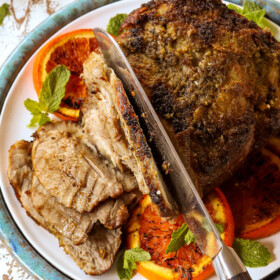
MOJO CUBAN ROAST PORK (LECHON ASADO)
Save This Recipe To Your Recipe Box
You can now create an account on our site and save your favorite recipes all in one place!
Ingredients
- 4-6 pounds Boston Butt or pork shoulder (preferably bone in) trimmed of excess fat
- 1 tablespoon Vegetable oil
Mojo Marinade
- 1 yellow onion peeled, roughly chopped
- 12 cloves garlic peeled
- 1 cup loosely packed cilantro
- 1/4 cup loosely packed mint
- 2-4 jalapenos seeded and deveined
- 1 1/2 tablespoons fresh oregano or 1 ½ teaspoons dried oregano
- 1 1/2 tablespoons ground cumin
- 2 1/2 teaspoons salt
- 2 teaspoons pepper
- 1 cup fresh orange juice
- 2 tablespoons orange zest
- 1/2 cup lemon juice
- 1/2 cup lime juice
- 2/3 cup extra virgin olive oil
- 1 teaspoon liquid smoke optional
Instructions
- Add the onion, garlic, cilantro, mint, jalapenos and fresh oregano (if using) to your food processor and pulse until very finely chopped, scraping the sides down as needed. Transfer to a large bowl and stir in all remaining mojo marinade ingredients.
- Remove 1 ½ cups of the marinade and store in an airtight container in the refrigerator (to serve with roasted pork).
- Transfer the rest of the marinade to a freezer bag and add the pork; turn to coat, squeeze out excess air and seal. Marinate the pork in the refrigerator for 12-24 hours (no longer!), turning the bag occasionally.
- When ready to cook, remove the pork from the refrigerator and let rest on the counter for 1 hour.
- Preheat the oven to 425 degrees F. Heat vegetable oil over medium-high heat in a large cast iron skillet. Wipe excess marinade off pork, then sear on all sides until browned.
- Place the pork on a rack in a roasting dish (or use halved onions to prop up if you don’t have one) with 1 cup of water in the bottom. Spoon some of the marinade from the bag over the top of the pork. Cover the pork with foil, slightly tenting in the middle so it is not touching the pork.
- Bake at 425 F for 30 minutes then reduce the temperature to 325 F and continue to roast for an additional 3 hours, adding additional water as needed so the water doesn’t dry up. Only check the water once an hour but don't stress it, it’s not the end of the world if you need to leave and it dries up.
- After 3 hours, remove the foil and baste the pork with the water/drippings in the bottom of the pan. Roast for an additional 30 minutes. The meat should very tender; about 180-190 F on an instant read thermometer, without touching the bone. (Although this pork does not require a meat thermometer because it will be cooked beyond overdone until tender.) If it's not tender, cook for an additional 30 minutes as needed.
- At this point, you can turn your oven to broil (without moving the pork) for a more caramelized exterior if desired; broil for 5-10 minutes, keeping an eye on it so it doesn’t burn.
- Transfer the pork to a cutting board and loosely tent with foil. Rest for 20 minutes before carving.
- Meanwhile, transfer the 1 ½ cups reserved UNUSED mojo sauce to a saucepan and simmer for 5 minutes while stirring occasionally, or until reduced by half. Stir in a couple tablespoons of drippings if desired for more succulent flavor. Slice the pork and brush with some of the mojo. Serve remaining mojo on the side.
Notes
Tips and Tricks
- Pork: Mojo Cuban roast pork can be made with either a 4-6-pound pork shoulder or Boston butt. Both come from the shoulder of the pig and not the rear. If you have a choice between Boston pork butt and pork shoulder, choose pork butt. It has more fat marbling throughout the meat so it emerges more tender. You may also use boneless if that’s all you can find.
- Fat cap: Boston butts have a fat cap, a layer of hard white fat that sits on top of the meat, sometimes as much has an inch thick. I recommend trimming all of it except 1/8-inch. The thin layer of remaining fat will create a self-basting effect as it breaks down and drips over the meat, resulting in extra juicy and extra flavorful pork, with little surface fat remaining after roasting.
- Temperature: Pork shoulder should be cooked to 180-190 degrees F for carvable tender, 205 degrees F for shreddable tender. This is far past the 145 degrees for safe consumption. You don’t need to worry about overcooking the pork except it will simply change from carvable tender to shreddable tender.
- Serving suggestions: See the post for serving side ideas and tons of ways to serve mojo pork.
HOW TO STORE and reheat
- Storage: Leftover lechon asado should be stored in an airtight container in the refrigerator. It should last up to 4 days.
- Reheat: Leftovers can be reheated in the microwave with some reserved mojo at 30 second intervals (it warms quickly!); or warm leftovers in a skillet with a drizzle of oil over medium-low heat with some reserved mojo until warmed through.
- Freeze: Freeze mojo marinade for up to 3 months. Freeze pork for up to 3 months and thaw in the refrigerator before serving.

Did You Make This Recipe?
Tag @CarlsbadCravings and Use #CarlsbadCravngs
Leave a Review, I Always Love Hearing From You!
Carlsbad Cravings© Original








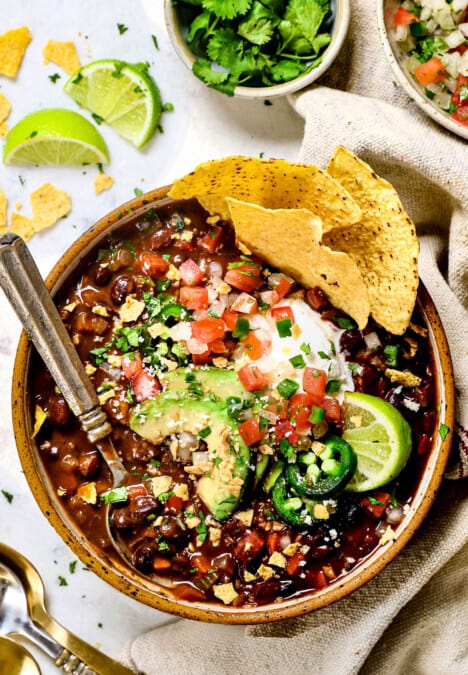
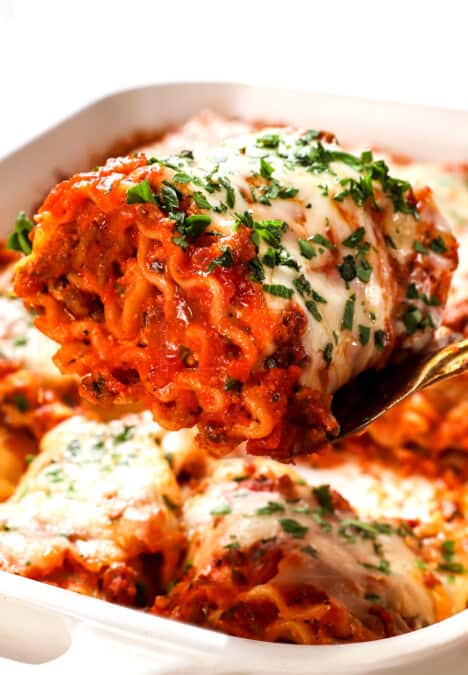























Darice T says
Jen – What did you mean hear?
“Reserve marinade. Remove 1 2/2 cups marinade to serve with Cuban roast pork.” I’m thinking 1 1/2 cups.
Jen says
Yes 1 1/2 cups, my apologies, it’s correct in the actual recipe.
April Smith says
Wow. This was insanely good. Even my 4-yr old devoured the tender pork. We are now even considering doing this for Thanksgiving rather than turkey! Can’t wait to try the Cuban sandwiches with the leftover tonight. Thanks for the great recipes!
Jen says
Yesss! Thanks for being the first to review this recipe April, I’m thrilled it was such a hit! I’m so honored you’re even thinking of making it for Thanksgiving – now that’s the ultimate compliment!
Jackie Testa says
Hi Jen,
My family and I love your recipes to the point that the majority of the recipes in my meal planner are from your web site. Thank you for helping me make food that I normally wouldn’t have tried because I would otherwise think it was too hard!
Quick question on this – I have a Ninja Foodi, so do you think I could pressure cook it and then turn on the roast option at the end? Or should I use the slow cooker option and then roast it at the end?
Jen says
Thank you for your super thoughtful comment Jackie, I’m honored you’re enjoying my recipes! As far as the Nina, I would use the slow cooker option then roast it at the end. Enjoy!
Ann L Shoemaker says
This was absolutely delicious. A definite keeper
Jen says
Thanks much Ann!
Rebecca in MD says
My husband and I loved this recipe. I had a 6 pound pork shoulder that I used in the recipe. I baked it in the oven and followed the recipe exactly. I took longer to reach temperature (170) than I expected. Next time I will make it in the slow cooker and then brown in the oven. The sauce and seasonings are excellent.
Jen says
Thanks for taking the time to comment! I’m sorry it took longer to cook but I’m glad the taste was a winner!
Dio Landeros says
Made this last night. Turned out really tasty. Used 2.5 pounds with the same cooking times and it turned out great. I did have to add additional water at the second and third hour.
Jen says
Thank you so much for the review Dio, I’m so pleased it was a winner!
YE says
I am Cuban. Your recipe is quite authentic, except for just a few minor details. For example, we don’t use jalapeños, but I don’t see how it would hurt to use it. If anything, it would add some extra kick that our lechon asado lacks. Also, authentic lechon asado uses a particular kind of orange called sour orange, which is different from your regular orange and it is very hard to find in the states. As a result, most people use a combination of regular orange, lime, and lemon to recreate that flavor profile. We don’t use cilantro either. Other than that, you did your homework very well and explained what lechon asado is to us to a T. Thanks.
Jen says
Thanks so much, I explained these differences in the post – I always want to give credit to the authentic versions!
B says
Can’t wait to try this. I don’t have a roasting pan. Can I do this in a Dutch oven using the 2 onion method, or, would a shallow pan be better?
Jen says
Yes, a Dutch oven will still work great, enjoy!